Everdell expanded review — Sylvanian family now including Pearlbrook, Bellfaire and Spirecrest
- This review was updated on 07/09/2021 to include details of each of the three Everdell expansions; Pearlbrook, Bellfaire and Spirecrest. You can read about each expansion at the bottom of this review, above the Conclusion section.
![Everdell]()
- Every now and then, a rare board game comes along that blends crunchy decisions and interesting combos with simple, clear mechanics that anyone can enjoy. Add incredible build quality, cute artwork and an unbeatable table presence into the mix and you’re certainly on to a winning formula. That, in an acorn-shell, is Everdell, and let me tell you —- it is every bit as good as the hype suggests. Keep reading and I’ll tell you why.
Overview
Everdell is a game of worker placement, resource collection and tableau building in a woodland realm populated by one to four groups of animals. Each player controls one such group, which will be represented in game by gorgeous little wooden animeeples. Everdell is set in a forest beneath the Evertree, which is represented in the game by a large, well made and gloriously detailed model that is included in both the basic and Collector’s Edition versions of the game.
The game takes place over three seasons, with each of the animal groups seeking to gather supplies and secure their position for the final scoring — which, thematically speaking, is winter. With each new season, one or two more workers are added to each animal group, but each player is free to decide when to move to the next season, which adds an additional layer of light decision making — do you attempt to progress first and grab actions early, or do you hang back and squeeze every drop of work out of the current season that you can?

In addition to the worker placement spots that allow players to collect one of the games resources, everyone also has a hand of personal cards, as well as access to a shared hand of eight cards that are placed on the board, in a location called The Meadow. Many cards can be played without an action (although they may cost resources) so whilst the game appears as if it will be very brief thanks to the low number of workers in hand, it is actually much more involved that you might think.
Once everyone has completed their actions for the final season (fall) the game ends. The winner is determined based on the sum total of points on all of the cards that players have in their personal tableau (up to a maximum of fifteen.) There are eight bonus objectives to score as well (four of which are randomised during setup) and some cards provide bonuses when combined, or bonuses for collecting certain resources or similar.

Components
Everdell is so, so beautiful, I’m not sure I have the vocabulary to do it justice. Even if they don’t like the game, I suspect some players might be tempted to keep it for sheer spectacle alone, as once the board is placed, and the Evertree set up, it just looks magnificent on the table. I should stress that I am reviewing the Collector’s Edition here, but the main difference is that this version includes gorgeous, shiny metal coins as well as some little wooden disks to show that a building is occupied, both of which are cardboard in the standard edition. there are three small expansions in the Collector’s Edition, which are the Legendary Expansion, the Extra! Extra! pack and the Rugwort solo expansion. These packs consist of twenty eight cards and some rat meeples for Rugwort’s crew.
The board itself is fantastic quality with absolutely gorgeous artwork that clearly depicts all of the key locations, without ever losing the sense of style that links visual functionality perfectly with the whimsical woodland setting of the game. On the board, the player will position a three-dimensional model of the Evertree, which towers over the board and features a couple of tiers of branches on to which cards and animeeples will be placed. There are also a number of bonus cards (some of which are random) that will be added to either the branches of the tree, in clearings around the board or along the river that runs across its top third.
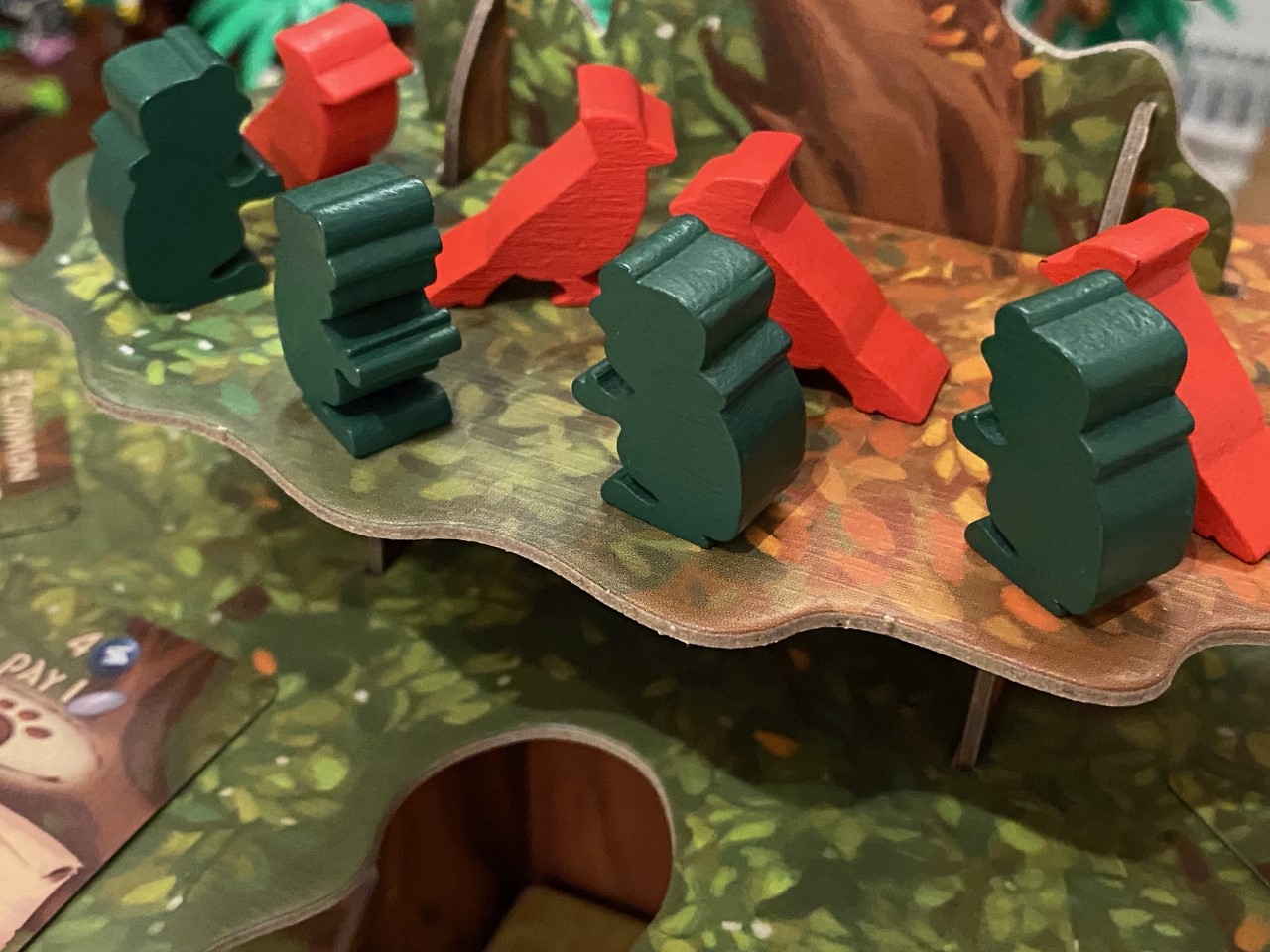
A shedload of realistic looking and nicely crafted resources (rolly wooden logs, hard, shiny stones, translucent, golden amber and squishy pink berries) are also placed along the river at their gathering locations, with the effect of both the tactile resources and the huge Evertree put together resulting in a nice sense of height, albeit one that is, unfortunately, purely cosmetic. There are, of course, the animeeples, money tokens and a few other components, but the final major piece of the puzzle (and the one that you’ll spend the most time staring at) is probably Everdell’s single, huge pile of cards.
Each player is dealt a hand of these (between five and eight) based on their starting position and a tableau of eight more will be placed onto the only bit of free space remaining on the board. There are over a hundred cards in the deck (including an advanced mini-expansion that i think you might as well use from the outset) and the artwork on each and every one is just adorable. About half the deck is made up of building cards, whilst the other half are the animals that occupy them. Most buildings are tremendously detailed, with creatures hiding behind stumps and scampering about in the background. The animal occupant cards provide close ups of the inhabitants of Everdell, with most being cute to a fault.

Turn Structure
Everdell is a relatively simple game that is very quick to teach, but with a pleasing amount of hidden depth that is slowly revealed to a new player over the course of the unfolding seasons. Beginning with just their hand of cards and a couple of animeeples in their chosen colour, players will take one action, which will generally be to place a worker or play a card. The trick here is realising that the eight cards on the board are freely available to the players, in addition to those in their hand.
Many cards can be played for free (or with a very low cost) so the focus is actually less frequently on the basic function of placing workers than you might think. The opening move is often to place a worker in order to obtain resources, but as building cards are placed, they often produce resources immediately anyway. Because each building is paired with one or more creatures, it’s also often possible to place an animal card with its paired building for free, even if it’s taken from the shared cards on the board.
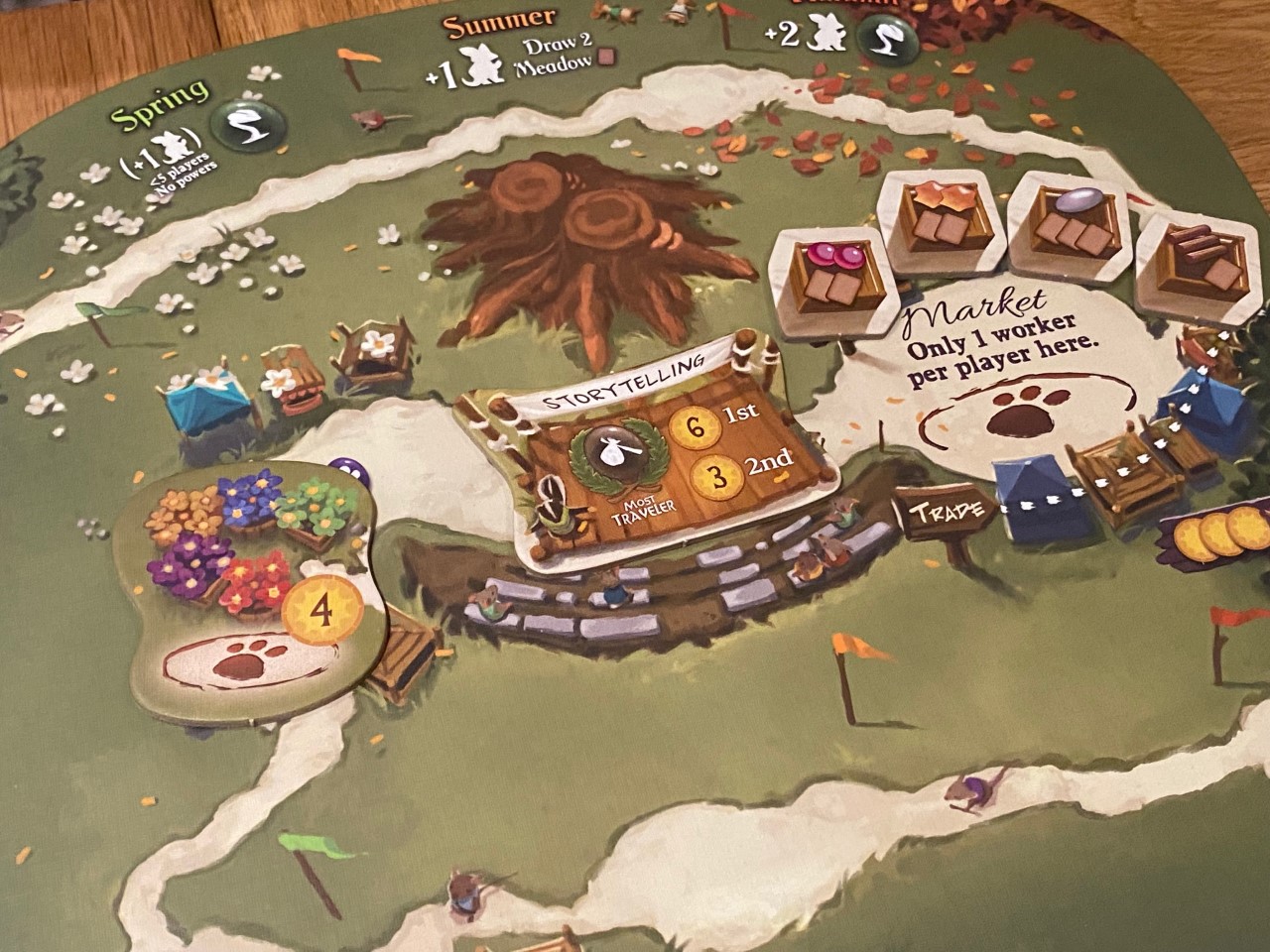
What this results in is the initial impression that the game might be quite brief (because everyone only has two animals) but in fact, it’s more likely that the first season will last four or five rounds of turns, with the second more than doubling in length and the third and final season taking up around half of the play time. As each season begins, the players will take one or two new workers to add to their pool (depending on the season.) At the end of a couple of the seasons, all buildings that previously produced when they were built, will produce again, generating a vast amount of resources for the final round of play.
As players collect resources, spend them on buildings, add animal cards and build out their personal tableau (up to a maximum of fifteen cards, unless a specific card breaks that rule) they will begin to notice more and more point scoring combos appear. Some cards care about other animals (like the Husband and Wife) whilst others care about resources in hand at the end of the game. Others give bonuses depending on how many buildings of a certain type you’ve constructed. These point scoring options drive player behaviour, because as you’ve probably guessed, the player who scores the most at the end of all seasons will be the winner.
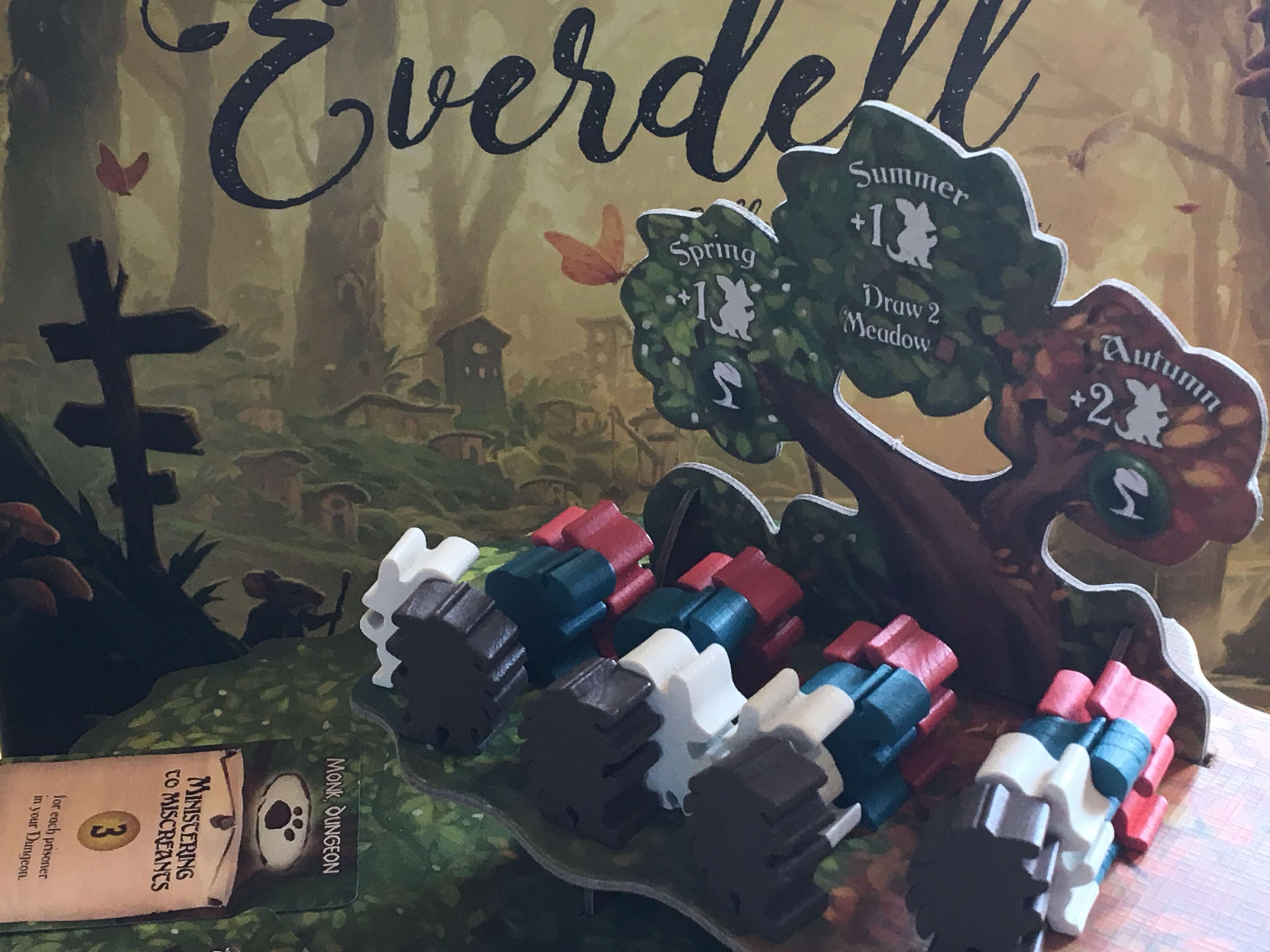
Game Experience
Playing Everdell is both relaxing and joyous and surprisingly taxing at the same time. You might be be drawn in by the gorgeous aesthetic and incredible table presence, but you’ll stick around for the simple, addictive mechanics. Over the course of only a few turns, the penny will drop and before you know it, you’ll be looking into maximising your point scoring engine and preparing to make the most of the next harvest phase.
Achieving the right balance of simplicity and depth is never easy and many board games simply don’t try, they unleash their full complexity (for better or worse) onto the player from the outset, which can create an artificial barrier of entry for some players that can’t be overcome. Everdell quite literally does the opposite. It begins with the most basic of worker placement actions and builds into a complex, brain burning mixture of decisions that focus on optimising every single action.
The term gateway game is now used so frequently that I’m not sure it has any value. What is a gateway game anyway? Often it simply seems to suggest that a game has to be as straightforward as something like Monopoly, yet I find that a lot of games carrying the label fail to prepare their charges for what modern board games are really capable of. Everdell might be the perfect gateway game based on my new definition. Why, you ask? Simply put, it does almost everything right — it’s beautiful and well made, it’s very simple and easy to teach, yet despite all that, it’s complex enough to develop some very competitive play. If I have one complaint about Everdell, it’s only that the final scoring can be a bit messy with the frequent need to recount when the score is close.

Expansion – Pearlbrook
Pearlbrook was the first expansion released for Everdell, coming some time before Bellfaire and Spirecrest, which launched simultaneously as part of a joint Kickstarter campaign. In a nutshell – or perhaps a clamshell – Pearlbrook expands nicely on almost every aspect of what players liked about the original game.
A new resource is introduced in the form of pearls, and an additional animal meeple (a Frog Ambassador) is added for each of the existing colours from the base game, plus one for each of the four new animal types/colours that are included in Pearlbrook itself. The box also includes four three-dimensional monuments that represent different wonders, and these sit along the top of the river on the base board, which is amended slightly by using a couple of overlay tiles.
Most prominently, Pearlbrook includes a new “side board” which literally snuggles up against the left hand side of the base board, joining the river and playing host to four cards (chosen randomly) from decks of underwater locations and citizens. The unique thing about water spaces is that only Frog Ambassadors can visit them, and each one (except the pearl gathering space) has a high barrier for entry – for example needing to have placed three Production icons, or two Critter icons in your tableau. Gathering pearls – which are worth two points at the end of the game – has no prerequisite, but it costs two resources and two cards, which is certainly expensive.
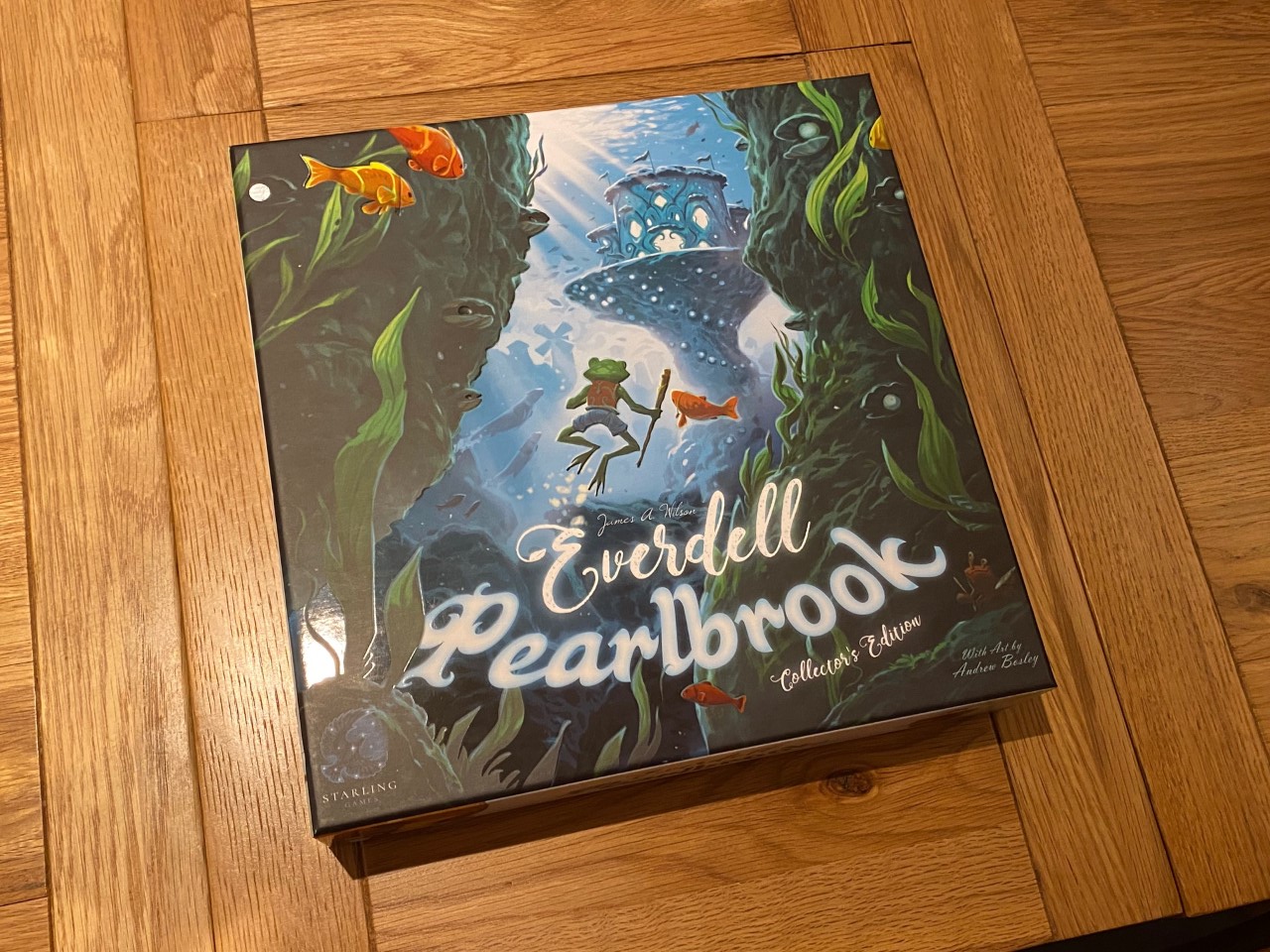
Players can get pearls for being the first to visit the underwater locations/citizens and flipping those cards over (which then become additional expansion spaces.) Sometimes these spaces allow pearls to be spend, as do some of the seasonal event cards that Pearlbrook introduces, but the main way in which you’ll spend pearls is by investing in the monuments, which are worth increasingly more points (right up to 25) should you be able to afford them.
Adornment cards (which also cost pearls and allow players to score points for fulfilling specific things also feature, as do around twenty additional woodland cards which are simply shuffled into the main deck. A scorepad is one of the last but by no means least components, and considering the scoring complexity of Everdell (with or without expansions) this is most welcome.
What works well in Pearlbrook is just how good it looks – adding to and enhancing one of the most beautiful games that I’ve played – and how it iterates on the basic experience really well, without making revolutionary changes. The new river board, which effectively removes the basic events from the base game feels like a natural addition, with the pearls and wonders folding into the game extremely well. The wonders are worth a huge amount of points and therefore drive your focus, but adornments are also worthwhile, and neither seem to “overshadow” the basic focus of building out your own city tableau.
Expansion – Bellfaire
With Bellfaire, players are treated to an expansion that I would say falls firmly into the “more of the same” category, offering a number of small expansions that can be used in a modular way. Like the other expansions, it adds another side board or two, although the setup instructions are keen to point out that you don’t always need those.
Among the additional modules is one of my favourites – that of specific player powers. Each of the different animal species now benefits from a specific power or ability, and it’s nice to see that Bellfaire includes cards for all (as far as I know) of the animals that feature in the base game and all of the expansions featured in this review and released at the time of writing. Also included in Bellfaire is my least favourite expansion – the player boards. These simply allow players to store resources and workers whilst giving them a “start” to place their tableau into – sadly, these stay in the box for me.

Fore the more material elements, Bellfaire includes a new board that features three key spaces. The first is the flower festival, which simply allows a player to take the “Flower Festival” event card when they have satisfied the requirement to have one requirement of each type. There is also a market space that allows players to Gain or Trade resources – gaining resources from one of four options on the top row and then moving the matching token down to the bottom Trade row, or paying resources for anything on the Trade row to take two resources of their choice and three money. This is a nice little addition that adds a lot of flexibility, and keeps things nice and simple.
A set of Garland award tiles can also be shuffled and one included at random, and these simply allow one player to score six points and another three (with friendly ties giving points to both tied players.) Garlands are super simple, acting mostly like any other event or award in terms of how you go after them. New Forest cards are also included, and there are a handful of Special Event cards as well, which you might choose to either shuffle into your main deck, or play with exclusively.

Where Bellfaire succeeds is with its simplicity and its modularity. It’s very simple to just throw a couple of these modules in – or indeed not – with any of the other base game or expansion content. For example, I would never not play with the specific player powers now, and each different critter all of a sudden has its own identity. The Market, I also like, but it is by no means a game changer – more like a nice, rewarding action that helps offer an option for every occasion.
Expansion – Spirecrest
By far the largest and most complex expansion to Everdell, Spirecrest introduces a large new board that adds to the bottom of the base game, and brings with it a load of additional content. For starters, there are new critters, and each of the species that exists both in this expansion and across the base game and other expansions also gets a rabbit explorer. Those rabbits are the brave souls who will adventure into the mountainous region of the titular spirecrest.
Whilst this additional board – and the focus on it when it is in play – adds some additional complexity, it’s all relative, and Spirecrest does not turn Everdell into a heavyweight experience. Almost all of the action in Spirecrest (aside from additional critters and a few new clearing and event cards) takes place at the end of each season – effectively giving the player options and decisions to make at a phase in the base game where not much usually happens.
In Spirecrest, when a player decides to end their season, they will do three things. Firstly, the player will chart their path – by taking one of the tokens in their current section of the journey. This token is then added to their existing “basic” map that was dealt during setup, and at the end of the game, will unlock an opportunity to score based on what is shown on it. Simply put, each player will chart three times per game (once per season) and during endgame scoring will move through their chart from left to right, paying a cost to earn points with each step – if a cost cannot be paid, progress stops.
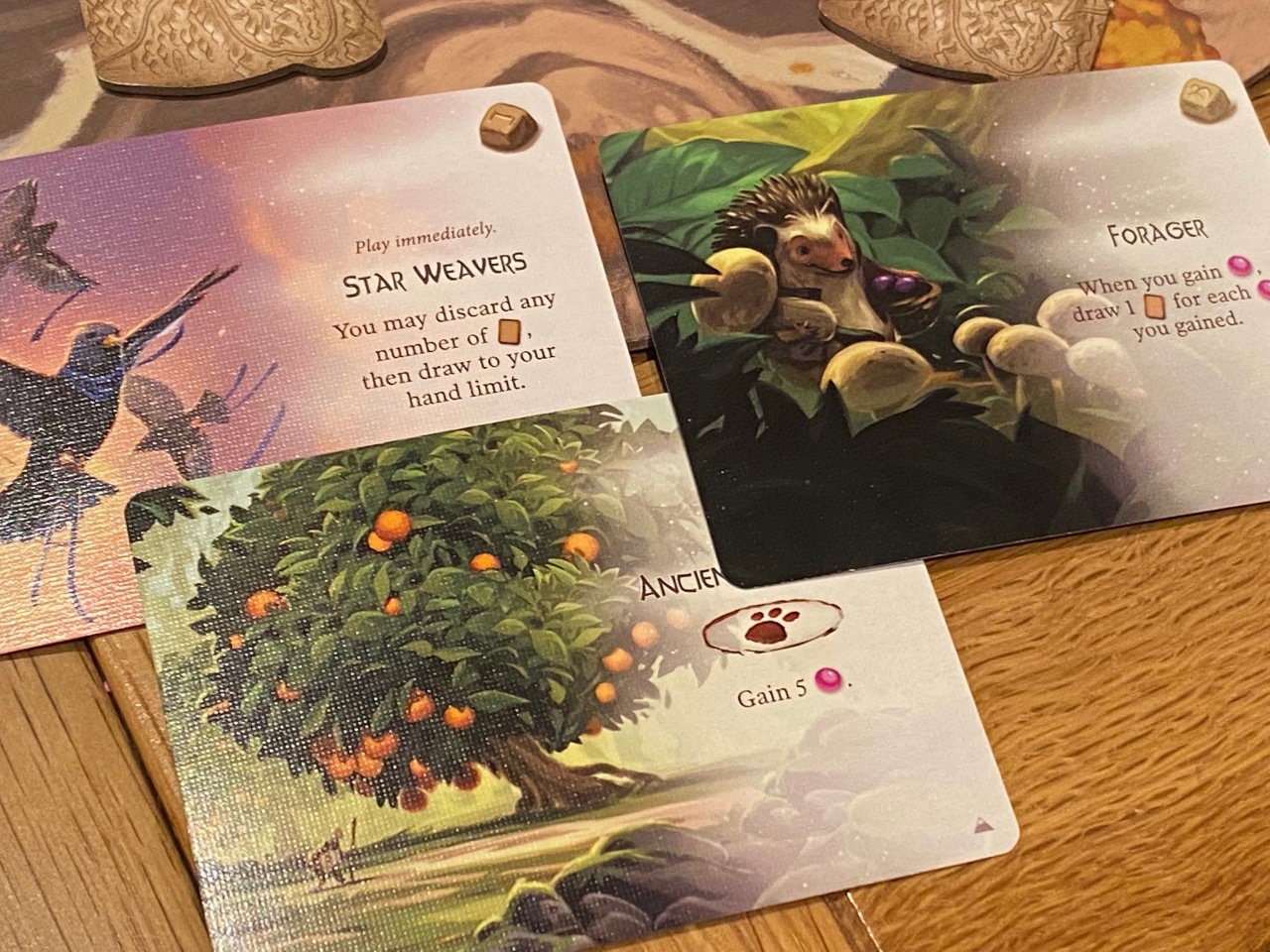
After charting, the player will then discover – this simply means they reveal three cards from the deck of the region in which they stand, placing them out beneath the board. The leftmost one is free, whilst the second and third cards revealed come with a cost as printed on the board. These cards do all kinds of cool things – for example offering an endgame scoring opportunity, a new worker space, or even one of the new “Giant Critter” meeples complete with saddle. If the player takes the latter option, they will place a regular worker (not the rabbit as per my pic, just for cuteness) onto the Giant Critter, bestowing a benefit on that worker for the rest of the game, activated each time they are used.
The final thing a player will do is Travel – which is to simply move their rabbit meeple along the track to the next seasonal region. In doing so, they will also reveal the chart tokens for the next season, and they will flip over the weather card. Weather will usually – but not always – have a negative effect, for example the Tornado, which means that players cannot take cards from the shared display on the base board. If anything, these weather cards are the only fiddly part of Spirecrest, because it can occasionally be easy to forget them, and have to undo a turn or action accordingly.
Much like Pearlbrook and Bellfaire, Spirecrest is a great expansion. It has the best expansion board of the three, but does away with the gimmick of large cardboard pieces and replaces it with, erm, large wooden critters. I mean gameplay – yes, definitely gameplay. In all seriousness, Spirecrest introduces an interesting new decision space that both stands alone as a feature in its own right, and it influences the main game without prolonging the play time.

Conclusion
And there you have it, I’ve reached my conclusion earlier than I should have, but I truly hold very few reservations about Everdell. I love the look of it, from the squishy berries to the gorgeous card art. Even the slightly over the top Evertree looks fantastic. Given that the creatures here are simply adorable, you might think that Everdell could be a bit saccharine for adult players, but it’s not — it’s an attractive, detailed theme that reminds me of warmth and love and childhood, but it never made me feel condescended to. As such, I can look at Everdell all day and I can’t wait to show my own children when they are older.
I’d show them now, except that the other side to Everdell, the side you can only experience (because it’s not really visible on the cards) is how deep the game is. I’ve played it with some of the best board gamers I know and we’ve had games that reached nearly a hundred points between the top players, yet there was only one or two points in it. We once had a game that was so tight, we drew on seventy three. Creating a game that has as many ways to win as Everdell does, but which remains as tight as it does is a real marvel.

Everdell is a superb game and a beautiful product. It deserves its recently held placement in the BGG hotness list and I hope it remains a popular choice that continues to impress new and old players alike. If you only buy one game this year, Everdell should be on the shortlist alongside the likes of Lords of Hellas and Lowlands, with only your personal preference to differentiate between those in the running.
A copy of Everdell was provided for review purposes. You can find out more about it on the website of publisher Starling Games.

Great review. The middle paragraph of the conclusion is especially helpful.
Thank you Dan – It’s fantastic to have positive feedback!
Are you planning to pick up the game? If so, I hope you enjoy it! 🙂
Regards
Matt